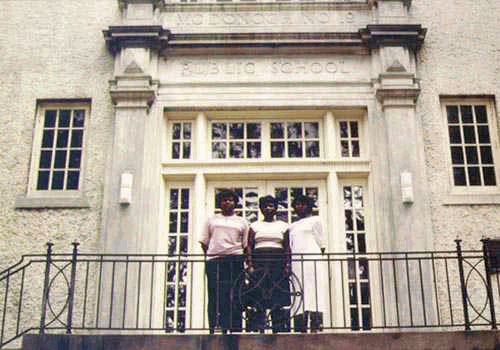|
Today in New Orleans History |
|
|
November 14


The Market Theatre Closes The Market Theatre, located on Teche Street near Foto's
Market, provided Algerines with silent movies and vaudeville acts. The theater's farewell performances took place on November
14, 1915. The next day, the owner, Philip Foto, opened a new movie house, Foto's Folly Theater which was later affiliated
with United Theaters, Inc. Foto, a New Orleans native also managed Panama Ice Company. He resided at 1801 North Broad, where
he died on Wednesday, May 2, 1956 at the age of 85. Mr. Foto is buried in Metairie Cemetery. (From the New Orleans Public
Library)
On November 14, 2008, the new slot-machine facility opened for operation at the Fair Grounds. Nov. 14, 2004 - RB Deuce McAllister set a personal career mark with TDs in four straight games as the Saints beat Kansas City, 27-20 in the Superdome Jazz trumpeter, bandleader, and occasional singer and flugelhorn player Theodore (Teddy) Riley, born
in New Orleans on May 10, 1924, the son of Amos Riley (c. 1879 - 1925), a New Orleans trumpeter and bandleader. Known
for playing jazz, he also worked and recorded with various Rhythm & Blues bands and artists including Louis Cottrell,
Jr., Fats Domino, Champion Jack Dupree, The Dookie Chase Orchestra, Roy Brown's Band, The Onward Brass Band, The Olympia Brass
Band, The Williams Brass Band, and The Royal Brass Band. In 1971 Riley played on the cornet used by Louis Armstrong
in his youth for the New Orleans ceremonies marking Armstrong's death. He made a guest appearance on Wynton Marsalis' 1989
release "The Majesty of the Blues." He performed both leading his own small band at hotels and clubs as well as
in various brass bands until just weeks before his death on November 14, 1992.
R.D. Farnsworth submitted plans for an addition to the Jung Hotel at 1500 Canal Street on November 14, 1962.
Bodman, Murrell and Smith submitted plans for the Provincial House of the Sisters of St. Joseph at 1649 Mirabeau Avenue on November 14, 1956. Photo of NORD football player Leonard McLannen on November 14, 1955. Born in New Orleans on November 14, 1945, Donald Boesch is Professor and President of
the University of Maryland Center for Environmental Science and Vice Chancellor for Environmental Sustainability for the University
System of Maryland. He grew up in the Ninth Ward, experienced the flooding resulting from Hurricane Betsy, and graduated
from Holy Cross and Tulane -- earning a B.S. in Biology. He completed his Ph.D. in biological oceanography at the College
of William of Mary in Virginia, after which he was a Fulbright-Hays Postdoctoral Fellow at the University of Queensland in
Australia. After returning to the the United States in 1972 he served as a professor at the Virginia Institute of Marine Science.
In 1990 he moved back to Louisiana to become the first Executive Director of the Louisiana Universities Marine Consortium,
where he was responsible for building its marine center at Cocodrie, Louisiana and two research vessels, the Pelican and
the Acadiana. During this time, he was also a professor of marine science at LSU. In 1990 he became head of the University
of Maryland Center for Environmental Science and served on the Maryland Governor’s Chesapeake Bay Cabinet. In 2010,
he was appointed by President Barack Obama as a member of the National Commission on the BP Deepwater Horizon Oil Spill and
Offshore Drilling to investigate the root causes of the blowout at the Macondo Prospect in the Gulf of Mexico. Boesch has
conducted research on coastal and continental shelf ecosystems along the Atlantic Coast, the Gulf of Mexico, eastern Australia
and the East China Sea. He has published two books and more than 90 papers on marine benthos, estuarine and continental shelf
ecology, wetlands, effects of offshore oil and gas development, nutrient over-enrichment, environmental assessment and science
policy. While in Louisiana, he initiated the research that documented the Gulf of Mexico Dead Zone and identified its principal
causes. His current research focuses on the use of science in ecosystem-based management and on assessments and adaptation
strategies related to climate change. He has served on numerous committees advising federal agencies and the National
Research Council of the National Academy of Sciences, where he is presently chair of the Ocean Studies Board and a member
of the Committee on America’s Climate Choices. He also serves on the Ocean Research and Resources Advisory Board,
the external committee providing technical advice to the National Ocean Council. In 2007 he was given the Award for Lifetime
Leadership in Ecosystem Restoration by the National Conference on Ecosystem Restoration. He is a member of the governing
boards of the Chesapeake Bay Foundation, Chesapeake Research Consortium, the Consortium for Ocean Leadership, and the Town
Creek Foundation. (From http://en.wikipedia.org/wiki/Donald_Boesch) Born in New Orleans on November 8, 1876, Arthur Joseph O’Keefe, Sr., was the 48th mayor of New
Orleans. A graduate of St. Aloysius High School, he operated his own coffee import company. Before becoming mayor,
O’Keefe was a prominent member of the Regular Democratic Organization, the political machine that had dominated New
Orleans for decades. He served as the RDO's Tenth Ward boss, the city’s Commissioner for Public Finance from 1925
to 1926, and after long-time mayor Martin Behrman died in office O’Keefe was elevated to serve the remainder of Behrman’s
term. O’Keefe’s term in office (1926 through 1929) was marked by a controversy over whether two bridges over the
Rigolets and Chef Menteur Pass would be toll-free bridges as advocated by Public Service Commissioner Huey Pierce Long, Jr.,
or toll bridges operated by a firm controlled by the mayor's political allies. O’Keefe also fought a bitter battle
with Huey Long over piping cheap natural gas into New Orleans; an ally of the New Orleans energy monopoly NOPSI, O'Keefe
unsuccessfully opposed the plan. Under O'Keefe's administration construction was begun on the Municipal Auditorium and plans
for the Criminal District Court Building and Orleans Parish Prison were drawn up. He also served as president of the RDO's
Choctaw Club. In July 1929, O’Keefe resigned as mayor for health reasons; he was succeeded by T. Semmes Walmsley.
He was also vice-president of the American Bank and Trust Company and director of the Lafayette Fire Insurance Company and
the Mutual Building and Loan Association. O'Keefe died on November 14, 1943. Several photos of Elysian Fields Avenue taken on November 14, 1938. Drummer Joseph "Smokey" Johnson, born in New Orleans on November 14, 1936,
is considered one of the musicians, session players, and songwriters who have served as the backbone for New Orleans' output
of jazz, funk, blues, soul, and R&B music during the mid-twentieth century. Raised in Treme, he attended
Craig School and Clark High School. He was Fats Domino's drummer for 28 years in the 1950s and 1960s.He has also worked with
Wardell Quezergue , Earl King, Joe Jones, Eddie Bo, Sugarboy Crawford, Red Tyler, Johnny Adams, and Dave Bartholomew
to name just a few. He said. “I used to work for Carlos Marcello at the Sho-Bar on Bourbon Street playing behind
Rita Alexander, the Champagne Girl. She used to dance to that tune ‘Goldfinger’ with two champagne glasses on
her titties. I was the only brother in the band. We had Don Seward on alto, he used to sound like Charlie Parker. He was
a hell of a player, he was bad. That was some fightin’ hours way back then. Bourbon Street ain’t the Bourbon
Street I remember. When I was playing down there, they had the dancers out on the street. If a black dude walked by the
joint the barkers closed the door where he couldn’t see in there. I mean, I’d be goin’ on my gig but the
cats would close the door when I passed by! Man, that was some crazy stuff." Ellis Louis Marsalis, Jr., born in New Orleans on November 14, 1934, is the son of
Florence Robertson and Ellis Marsalis, Sr. (who was a businessman, hotel owner, and social activist) and the father
of musicians Wynton, Branford, Delfeayo and Jason. Active since the late 1940s, Marsalis came to greater attention in
the 1980s and '90s as the patriarch of a musical family, with sons Branford Marsalis and Wynton Marsalis rising to international
acclaim. He played with fellow modernists including Cannonball Adderley, Nat Adderley, and Al Hirt, becoming one of
the most respected pianists in jazz. He has recorded almost twenty of his own albums. As a leading educator at the New
Orleans Center for Creative Arts, the University of New Orleans, and Xavier University of Louisiana, Ellis has influenced
the careers of countless musicians, including Terence Blanchard, Harry Connick Jr., Nicholas Payton; as well as his four musician
sons. In May, 2007, Marsalis received an honorary doctorate from Tulane University for his contributions to jazz and
musical education. On December 7, 2008, Ellis Marsalis was inducted into The Louisiana Music Hall of Fame. The Ellis Marsalis
Center for Music at Musicians' Village in New Orleans is named in honor of Ellis Marsalis. In 2010, The Marsalis Family released
a live album titled Music Redeems which was recorded at The John F. Kennedy Center for the Performing Arts in Washington,
DC as part of the Duke Ellington Jazz Festival. All proceeds from the sale of the album go directly to the Ellis Marsalis
Center for Music. Marsalis and his sons are group recipients of the 2011 NEA Jazz Masters Award. 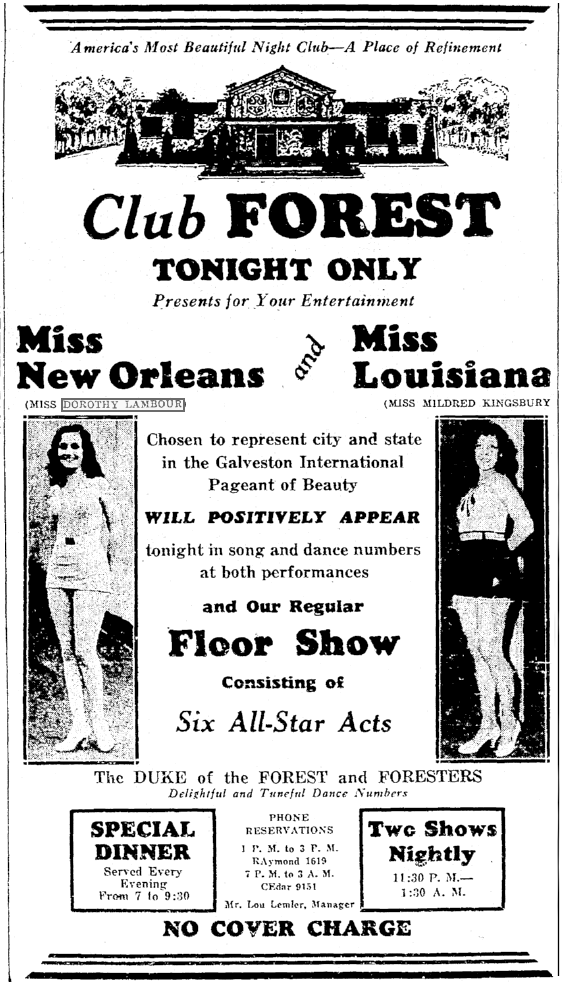 Dottie Lambour won the 1931 Miss New Orleans contest wearing a blue bathing suit and a blue linen
dress she had bought on Canal Street for $2.98. Miss Lambour is seen here in an advertisement for Club Forest (407 Jefferson
Highway) on June 7, 1931. She did, in fact, go on to the 1931 Galveston pageant but failed to take a crown. She
attended Spencer Business College and took a job in the real real estate business but still dreamed of fame. According
a 1974 interview with local writer David Cuthbert, Dottie bought two tickets to Chicago, left one along with a note to her
mother, and left New Orleans for a bigger city. Her mother arrived the following day. They took jobs in a restaurant,
with Carmen in the kitchen and Dottie waiting tables. She said the trays were too heavy for her to carry so "I
walked into Marshall Field Department Store. I had a terrible inferiority complex but when you do you put up more of
a front." "I want to see the supervisor" she said, to which the response was "Which one?"
"Well that stopped me. At D.H. Holmes and Maison Blanche all they had was one. In those days at Marshall Field
they had nine. All I could get out was 'I want to ride an elevator'. She got the job.While performing at a night clubs she
was "discovered" by orchestra leader Herbie Kay who hired her to sing for his band. On November 14, 1932 she was back in New Orleans and back at Club Forest performing with
Kay's "nation-wide famous band" featuring Dorothy Lambour (Miss New Orleans 1931)". She later said that
a Dallas sign painter left the "B" out in her name on a hotel display announcing the band's performances and that
Herbie Kay adivised her to let it be, and so she became "Dorothy Lamour". She also became Mrs. Herbie Kay/Mrs.
Herbert F. Kaumeyer on Monday, May 13, 1935. "Without Herbie, I don't think I'd be in show business", she said. Dottie made a total of 50 flims, seven of them in the "Road to..."
series. During World War II she performed for GIs, hosted at USO facilities, was one of the most popular pin-up girls,
and was not only the first star to volunteer to sell war bonds but is also credited with selling some $300 million
worth of them. In later years she toured with theatrical shows and became more active in volunteer service. Referring
to the 1987 film ''Creepshow 2,'' where she played sloppily housewife who is murdered, she said ''Well, at my age you can't
lean against a palm tree and sing 'Moon of Monakoora.'' Dottie died on September 22, 1996 in North Hollywood at the age of
81.
Mark S. (Humpty Dumpty) Polhemus, born on October 14, 1860 in Brooklyn, played on the 1889 New Orleans
Pelicans team, leading the league in batting average, hits, doubles, and runs scored in the year New Orleans won the pennant.
Polhemus died on November 14, 1923 at the age of 63. Born in Baltimore on November 14, 1916, Don Ewell was a jazz pianist best known for
his work with prominent New Orleans–based musicians such as Sidney Bechet, Kid Ory, George Lewis, George Brunis, Muggsy
Spanier and Bunk Johnson. From 1956 to 1962, Ewell was a leading member of the Jack Teagarden band. Following Teagarden's
death Ewell did some European tours, and then moved back to New Orleans and played clubs and hotels until his death on August
9, 1983.
An ordinance was passed providing a Public Square (later named Tulane Park) created by the intersection of Banks and Common Streets, extending from Galvez to Prieur Streets on November 14, 1896. Born in born in Seloncourt, France on November 14, 1822, George David Coulon's family
moved to New Orleans in the summer of 1833. Educated in the public schools, he then studied
art in the city with Louis David, Jacques Amans, took drawing lessons with Toussaint Bigot, had lessons in portraiture
from François Fleischbein, and studied decorative painting with Antonio Mondelli. In Paris he was a student of Anne-Louis
Girodet. Coulon assisted his son-in-law, Leon Pomarede, in painting a copy of Raphael’s Transfiguration on the altar
wall of St. Patrick's Church. He also assisted in frescoing the ceiling of the Old Criminal Court in the Cabildo.
In 1840 he took lessons in portraiture from Julien Hudson and more lessons from Bigot in figure
and landscape. He painted his first portrait in 1841. After 1845 he did conservation work
by relining and restoring old paintings. In 1848 he painted a large work entitled Worshipping
of the Shepherds. He married Marie-Paoline Casbergue (1831–1914) on March 19, 1850, a New Orleans native
and artist known for still lifes of birds and game. They had two children, Mary Elizabeth Emma Coulon (1859–1928)
and George Joseph Amede Coulon (1854–1922), who were also well-known artists. Coulon worked as an artist and teacher
of drawing and painting in New Orleans for more than fifty years, from 1851 to 1865. He was one of the founders of the Southern
Art Union and the Artists Association of New Orleans. Some of his major portrait commissions
include: several of Msgr. Antoine Blanc, first archbishop of New Orleans; two of Rev. F. Mullen, founder of St.
Patrick's Church; Laurent Sigur, founder of The Delta newspaper; one of Capt. Tos. Fry, the Cuban martyr;
two of Col. W. Wright, U. S. Commissioner, and portraits of ten Louisiana Supreme Court justices.
He also painted portraints from masks taken after death. He died in New Orleans on February 28, 1904 and was interred in
St. Louis Cemetery No. 3.
|
|
|

To receive an update for each day in New Orleans history,
join our facebook page - Today in New
Orleans History.
Analytics |

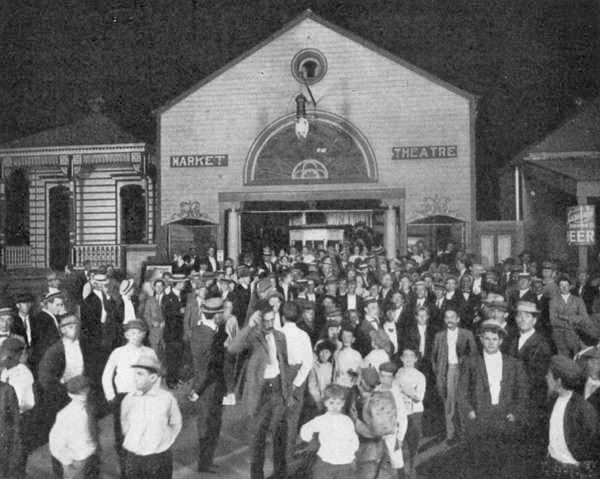

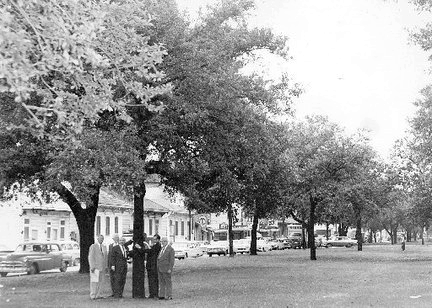 The designated route of Interstate 10 through New Orleans called for it to
run along North Claiborne Ave. On November 14, 1961, city officials met on the avenue's neutral ground
at Dumaine St. to mark its oak trees that were to be "saved." They are, from left, Herman Farley, president
of Parks and Parkway Commission; Wilson S. Callender of New Orleans Floral Trail; Mayor Victor Schiro; Felix Seeger, commission
superintendent, and Max Scheinuck, chairman of the ground committee. Only
51 of the 253 trees from Canal St. to Elysian Fields Avenue were deemed salvageable in a move The Times-Picayune editorialized
was "indispensable to general progress." Removal of the trees did not occur until February 1966. Many cite
the destruction of this leafy boulevard and its vibrant community life as start of Treme's downward spiral. Removal of
this stretch of the interstate has been suggested in several
post-Hurricane Katrina plans. (From the Times-Picayune)
The designated route of Interstate 10 through New Orleans called for it to
run along North Claiborne Ave. On November 14, 1961, city officials met on the avenue's neutral ground
at Dumaine St. to mark its oak trees that were to be "saved." They are, from left, Herman Farley, president
of Parks and Parkway Commission; Wilson S. Callender of New Orleans Floral Trail; Mayor Victor Schiro; Felix Seeger, commission
superintendent, and Max Scheinuck, chairman of the ground committee. Only
51 of the 253 trees from Canal St. to Elysian Fields Avenue were deemed salvageable in a move The Times-Picayune editorialized
was "indispensable to general progress." Removal of the trees did not occur until February 1966. Many cite
the destruction of this leafy boulevard and its vibrant community life as start of Treme's downward spiral. Removal of
this stretch of the interstate has been suggested in several
post-Hurricane Katrina plans. (From the Times-Picayune)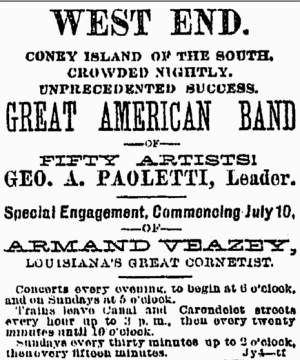
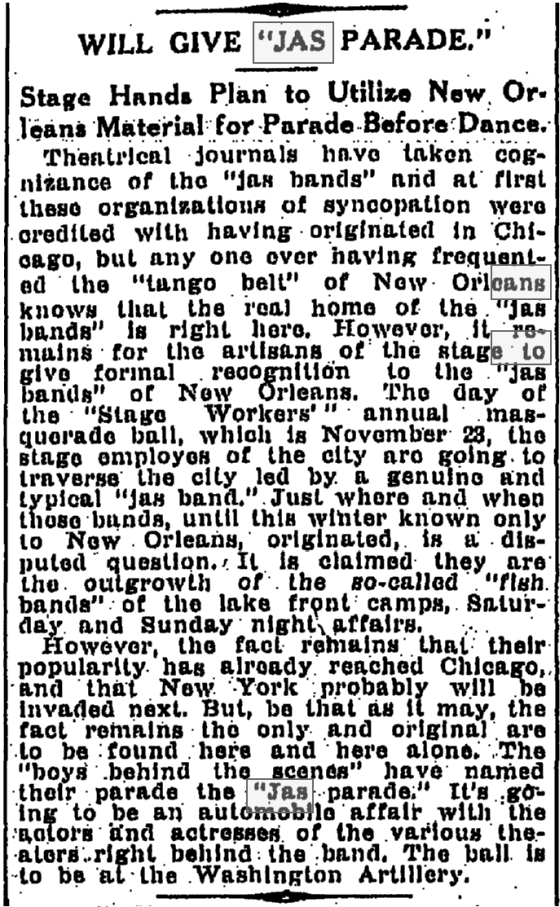
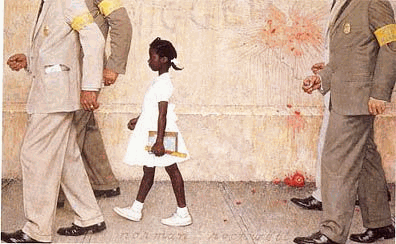 Most New Orleanians, in fact most Americans, know of Ruby Bridges who, as a six-year-old first-grader, climbed the long stairs
to the entrance of William Frantz Elementary School at 3811 North Galvez Street on the day the city's schools ended racial
segregation while some of its citizens displayed vehemently and cruelly some of the worst traits in human nature. Norman Rockwell
captured the moment when U.S. Marshalls accompanied her amid hate-filled screams of adults and children alike.
Most New Orleanians, in fact most Americans, know of Ruby Bridges who, as a six-year-old first-grader, climbed the long stairs
to the entrance of William Frantz Elementary School at 3811 North Galvez Street on the day the city's schools ended racial
segregation while some of its citizens displayed vehemently and cruelly some of the worst traits in human nature. Norman Rockwell
captured the moment when U.S. Marshalls accompanied her amid hate-filled screams of adults and children alike. 